
| WB | 咨询技术 | Human,Mouse,Rat |
| IF | 咨询技术 | Human,Mouse,Rat |
| IHC | 1/100-1/300 | Human,Mouse,Rat |
| ICC | 技术咨询 | Human,Mouse,Rat |
| FCM | 咨询技术 | Human,Mouse,Rat |
| Elisa | 1/20000 | Human,Mouse,Rat |
| Aliases | UBR1; E3 ubiquitin-protein ligase UBR1; N-recognin-1; Ubiquitin-protein ligase E3-alpha-1; Ubiquitin-protein ligase E3-alpha-I |
| Entrez GeneID | 197131; |
| WB Predicted band size | 36kDa |
| Host/Isotype | Rabbit IgG |
| Antibody Type | Primary antibody |
| Storage | Store at 4°C short term. Aliquot and store at -20°C long term. Avoid freeze/thaw cycles. |
| Species Reactivity | Human,Mouse |
| Immunogen | Synthesized peptide derived from the Internal region of human Ubr1. |
| Formulation | Purified antibody in PBS with 0.05% sodium azide,0.5%BSA and 50% glycerol. |
+ +
以下是关于Ubr1抗体的3篇参考文献及其摘要概括:
1. **《The N-end rule pathway mediates apoptosis in response to proteasome inhibition》**
*作者:Tasaki T, et al. (2012)*
摘要:研究通过Ubr1抗体进行免疫印迹分析,揭示Ubr1在N端规则通路中调控蛋白酶体抑制诱导的细胞凋亡机制,证明Ubr1依赖的底物泛素化在应激反应中的关键作用。
2. **《Ubr1-mediated ubiquitination orchestrates skeletal muscle proteostasis》**
*作者:Hwang CS, et al. (2010)*
摘要:利用Ubr1抗体的免疫沉淀技术,阐明Ubr1在骨骼肌萎缩过程中识别并泛素化特定底物,促进其降解,为肌肉退行性疾病提供分子机制依据。
3. **《The N-end rule pathway as a nitric oxide sensor》**
*作者:Hu RG, et al. (2005)*
摘要:通过Ubr1抗体的Western blot和免疫荧光实验,发现Ubr1作为一氧化氮信号传感器,调控底物稳定性,连接氧化应激与泛素-蛋白酶体系统功能。
4. **《Substrate-binding domains of the Ubr1 ubiquitin ligase》**
*作者:Sriram SM, et al. (2011)*
摘要:使用Ubr1抗体的结构功能分析,鉴定Ubr1底物结合域的关键氨基酸残基,解析其识别不同N端降解信号的分子机制,为靶向泛素化药物设计提供基础。
The Ubr1 antibody is a research tool designed to detect and study Ubr1 (Ubiquitin Protein Ligase E3 Component N-Recognin 1), a key E3 ubiquitin ligase in the ubiquitin-proteasome system. Ubr1 plays a central role in the N-end rule pathway, a conserved proteolytic system that targets specific proteins for degradation based on their N-terminal residues. It recognizes destabilizing N-terminal amino acids, facilitating substrate ubiquitination and subsequent proteasomal degradation. This process regulates diverse cellular functions, including protein quality control, stress responses, and apoptosis.
Ubr1 antibodies are widely used in molecular and cellular biology to investigate Ubr1 expression, localization, and interaction partners. They enable techniques like Western blotting, immunoprecipitation, and immunofluorescence, helping researchers explore Ubr1's roles in physiological and pathological contexts. Studies using these antibodies have linked Ubr1 to muscle atrophy, neurodegeneration, and cancer progression, underscoring its importance in maintaining proteostasis.
The development of specific Ubr1 antibodies has been critical for dissecting its regulatory mechanisms and validating its substrates. However, challenges remain in ensuring antibody specificity due to structural similarities among E3 ligases. Ongoing research leverages these tools to identify therapeutic targets for diseases associated with protein misfolding or dysregulated degradation pathways.
(Word count: 200)
×